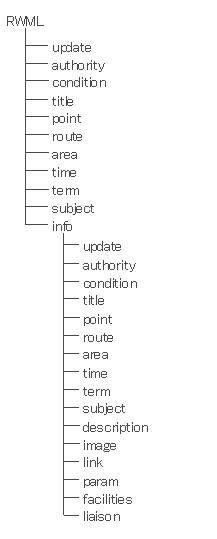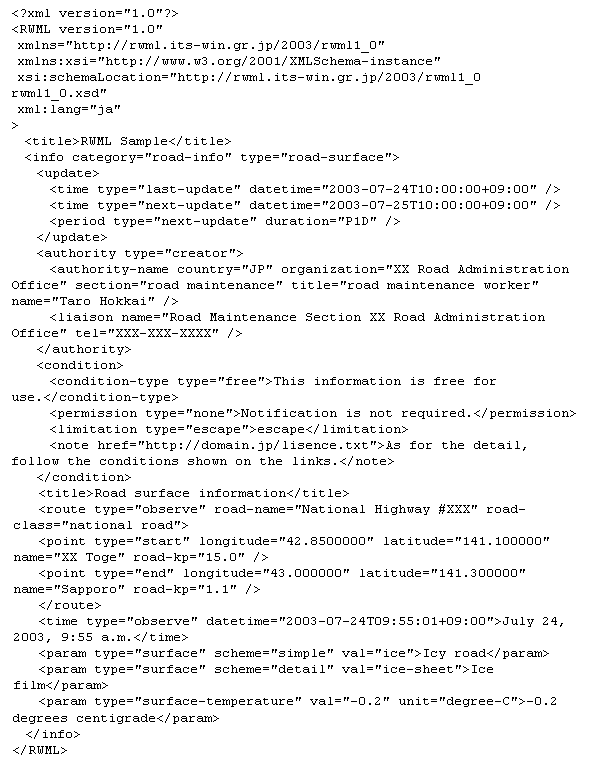| The Civil
Engineering Research Institute is investigating a road information
system in which data of roads described in Road Web Markup
Language (RWML) run on networks by the introduction of cutting
edge Internet technology XML. Today, the development of RWML
is being investigated by the Institute and a joint research
group. |
|
|
 |
The explosive popularization of the Internet has also given a great impact to ITS. Many advanced road authorities started provision of road information via Internet.
|
 |
Car-navigation systems with mobile communication function and In-car PC have appeared on the market. In addition, various automobile and electric appliance manufacturers have launched information services using Internet technology for vehicles in Japan. To say that the era of the network-connected car is approaching is no exaggeration.
|
 |
When the era of such a network-connected car arrives, we can estimate that information provided for drivers will be higher value added: road information provided by regional road authority via Internet will be utilized combined with other information. The potential to develop a new industry will arise.
|
|
|
 |
Internet homepages are written in Hyper Text Markup Language (HTML). HTML was made for describing format and layout of the contents such as text and images, and hyper links to jump to other pages and servers. HTML is easy-to-use plain text and using pairs of tag to describe these rules.
|
 |
In contrast, XML (eXtensible Markup Language) extended the rules of HTML and defined the general method of extending to describe machine-readable structured data. XML uses pairs of special tag, and makes the data easily understandable to user side.
|
 |
The first recommendation of XML specification was published by W3C (World Wide Web Consortium) which promotes the standardization of Internet technology in February, 1998. XML technology has lately attracted considerable attention especially in EC (Electric Commerce) field. In this field, the information systems are required searching suitable shops and goods based on the customer's request.
|
 |
The Civil Engineering Research Institute and Joint Research Group including Omron Corporation, Nagoya Electric Works Co., Ltd., Mitsubishi Electric Corporation, Japan Weather Association Hokkaido Regional Office, Nippon Koei Co., Ltd. intended the use of XML technology in road information systems field and started the development of XML Technology-based Road Web Markup Language (RWML).
|
 |
RWML is a useful tool to disseminate road information via Internet for secondary use. RWML data will be so easy to collect and handle that it will be possible to build a new road information system which can deliver much more value-added information to users by combining road information with weather forecast and local event information. For that reason, RWML we developed include weather, disaster and regional information in addition to road information.
|
 |
RWML is available for all data of Road Administrators and relevant organizations use. if Road Administrators set up RW (Road Web or Roadside Web Server) on roadside for collecting data automatically, they are able to construct Road Administration System based on internet technology.
|
 |
RWML consists of the following four parts, 1) Road Information; it describes information of road and traffic condition. Road weather data at roadside weather stations, road surface condition, monitoring camera images, traffic congestion and regulation, traffic volume and travel time, specific place information such as attention, view and feature are included. 2) Weather Information; it describes information from weather organizations. Now-casting and forecasting weather information are included. Warning information is also included. 3) Disaster Information; it describes information of natural disasters which affects or will affects road and traffic condition. Information of earthquakes and tidal waves, disaster prevention-related organizations, evacuation routes and restoring activities are included. 4) Regional Information; it describes local event information at such as road stations and sightseeing spots information for tourist convenience. Event name, date and period, place, content and photo image are included.
|
 |
These data are maintained by different authorities that every data section must have basic information such as place, update, authority and providing condition. Fig.1 shows basic structure of RWML, and Fig.2 shows the example of road surface information described by RWML.
|

Figure 1. Basic Structure of RWML.

Figure 2. Exmaple of the RWMl Description.
|
|
 |
RWML has been updated several times by a RWML technological study working group in which the Civil Engineering Research Institute played a central role. Moreover, RWML was equipped on field experiments and its practicability was confirmed in the course of the government-private sector joint research, "Study on Utilizing Technology of In-Transit Advanced Information Communication Society Retailing Information". After modifying and improving its specification in four field experiments, we verified the feasibility of the design and operation of the system with RWML technology, and confirmed information items. Although we have shown significantly good results, some problems, such as difficulty in developing applications that process RWML, were left to be solved before its technology could be widely used.
|
 |
In order to make RWML prevalent, our collaboration group overcame these problems and developed RWML ver1.0. With large-scale refinements to improve RWML's previous versions, introducing Basic Styles, and making it compliant with XML Schema, RWML ver1.0 is simple to use and has good prospects for the future.
|
 |
Since it is compliant with XML Schema, it became possible to specify a data type such as dates, character strings, and numerical values. Moreover, since it became possible to support it with tools compliant with XML Schema, application development became easy under an appropriate environment. Furthermore, by making RWML Version 1.0 compliant with XML namespace, it became possible to handle and integrate different XML texts, and to import the standard XML data for other fields.
|
 |
As you can see from the above explanation, RWML ver 1.0 has a structure with which we can easily develop and improve, and the extensibility of the specification itself is also improving. In accordance with the creation, application models will also be released, and it is hoped that the use of RWML ver1.0 will gradually become popular.
|
|

